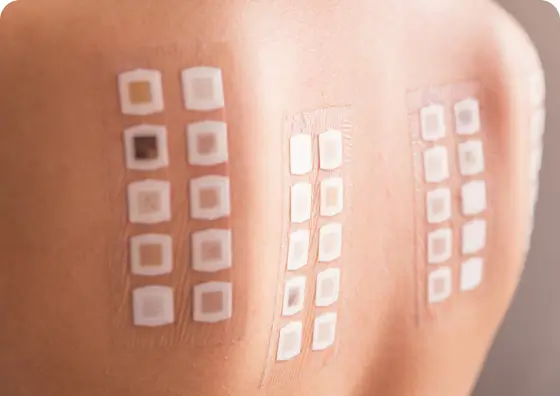What is patch testing?
Allergy patch testing is a common allergy testing method used to confirm the cause of allergic contact dermatitis in a patient. Allergy patch testing is also a preferred method for identifying delayed allergic reactions that may take several days to present and are known as type IV hypersensitivity reactions.
It is an easy and topical process that involves little pain or inconvenience for a patient. All testing is done on the upper back so as not to limit a patient’s movement. The procedure involves no pricks or scratches to the skin.
it is an easy and topical process
Patch testing is a different procedure than skin prick testing. Skin prick testing is used by allergists to determine which foods or allergens are triggering an acute or immediate allergic reaction in a patient. Patch testing, on the other hand, is used solely to determine whether a patient’s dermatitis is caused by some substance in the patient’s environment, including metals, preservatives, medications, etc.
How does patch testing work?
Patch testing is the fastest way to find out what in the environment is causing contact dermatitis. Because of these tests, patients will be able to avoid these things in their daily lives and reduce or get rid of their contact dermatitis symptoms. Patients may feel some light itching or burning but putting it on is easy and doesn’t hurt the skin.
01
The doctor puts a series of square patches on the back of the patient’s upper arm. A tape-like glue holds these patches lightly to the skin. Each patch has a number of allergens that are common and can cause contact dermatitis. The patient wears these patches for three days, and on the third day, you go back to the doctor for observations.
02
During this visit, the allergist looks at the skin and makes marks to keep track of any early skin reactions. The patient then comes back for a second check-up on day five. This appointment is used to find out if the patient has had any delayed type IV hypersensitivity reactions to an allergen.
03
Once the testing is done, the allergist will figure out which allergens the patient’s body reacts to, go over the results with the patient, and come up with a plan to treat the patient’s contact dermatitis.
Patch Testing Side Effects
During testing, patients may experience some flare up of their dermatitis, along with associated aggravation and itching. These symptoms will resolve after the removal of the testing patches. It is important that patients avoid scratching the area during the testing period. Any patient who experiences extreme pain or distress during testing should contact their doctor immediately.
How to prepare for patch testing
Since patch testing involves adhering testing patches to the skin, it is important that patients adequately prep the skin before their test to ensure they have a more positive experience and receive the most accurate results from the testing.
- Wear comfortable, loose clothing on testing day
- Avoid applying any perfumes or creams on testing day
- Shave any excess hair on your upper back
- Avoid using topical steroids on back for 2 weeks prior
- Avoid sun exposure for 1 to 2 weeks prior
- During testing period, avoid sun exposure, showering, and excessive sweating
Results from patch testing
Patients can have any one of several different reactions and results to skin patch testing. There are three general categories of positive results: mild redness, bright red, and blistered skin. The more severe the reaction to the allergen is, the more sensitive a patient is to that substance.
Light reactions indicate some but not much sensitivity to a substance. All results can help a patient and their doctor develop a comprehensive treatment plan, including developing a list of which substances to avoid. Negative tests are typically a confirmation that a patient is not allergic to that substance. It is important to understand that patch testing often involves narrowing down a list of triggers and can be part of an ongoing process of diagnosis.


